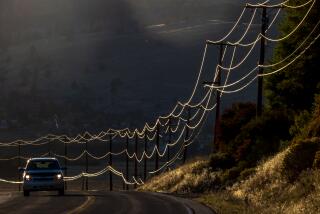City OKs Water Rate Drop for Some Users : Utilities: Decision ends two years of debate by giving breaks to those with large families, large lots or hotter weather. Critics say the system favors the Valley at the expense of other areas.
- Share via
Culminating nearly two years of study and often heated debate, the Los Angeles City Council voted Wednesday to provide water rate relief to residents who live on large lots, have large families or reside in hotter climates.
Because the water rate changes would mostly benefit San Fernando Valley residents, the issue has pitted Valley lawmakers against council members from other communities, where rates will increase for many users.
The two sides squared off again Wednesday as the council voted 8 to 4 for the new rates. Because the measure failed to receive a 12-vote majority, it will require a second vote next week before it goes to Mayor Richard Riordan.
But no new opposition is expected, and the changes will probably take effect June 1.
Supporters say the water breaks will make the Department of Water and Power’s rate formula more equitable for residents who have paid huge water bills in the past due to circumstances beyond their control, such as hotter-than-average weather and lot size.
“It’s an improvement,” said Councilwoman Laura Chick, who represents a Valley district where 45% of the households will have their rates reduced. “I think some people in the San Fernando Valley will get the benefits they deserve.”
But opponents say the breaks are unfair because residents who do not qualify will face higher rates.
“The difficulty I have is that (the breaks) come out of the hide of my constituents,” said Councilman Mark Ridley-Thomas, who said about 25% of the households in his south Los Angeles district will see higher water bills. He joined council members Rita Walters, Nate Holden and Rudy Svorinich Jr. in opposing the breaks.
The water rate debate originated in early 1993 when the city adopted a two-tier rate structure designed to promote water conservation by imposing a high rate for customers who use more than twice the city’s median amount of water, and a lower rate for more frugal users.
But in the summer of 1993, Valley residents flooded City Hall with phone calls and letters, complaining about water bills that, in some cases, skyrocketed to as much as $900 for a two-month period.
In response to such complaints, Riordan reconvened the Mayor’s Blue Ribbon Committee on Water Rates--the same panel of citizens that developed the two-tier system--and instructed it to address the complaints.
In June, 1994, the panel voted to keep the basic two-tier formula intact to promote conservation. But the committee also proposed breaks for residents who have large lots, big families or live in hot climates. Such residents can use an extra allotment of water before the higher water rate kicks in.
But when that formula finally reached the City Council last month, neither opponents nor supporters could generate enough votes to adopt or kill it.
The deadlock was apparently broken after Councilwoman Jackie Goldberg, who represents Hollywood and surrounding areas, offered a compromise measure that automatically gives breaks to residents in 24 ZIP codes in the Valley as well as south Los Angeles and the Eastside, where large families are prevalent, city officials said.
Goldberg proposed the amendment because under the original rate structure, large families had to apply to the DWP for the relief. Goldberg said many residents may not file the paperwork needed to get the break.
Under Goldberg’s amendment, all water users in the ZIP codes would get the breaks, but DWP officials would attempt to identify all those households that do not have more than seven family members and therefore do not qualify for the break.
At one point, Goldberg’s amendment was bogged down in legal problems because the city attorney’s office said it was discriminatory because it gave relief to everyone in the targeted ZIP codes, whether a household had reasons for needing more water or not.
The legal problems, however, were eliminated when DWP officials said they would weed out the small families in the ZIP codes who did not qualify for the breaks.
Goldberg’s amendment could cost the city up to $500,000 per year, depending on how many families take advantage of the breaks, DWP officials said.
Some residents who do not qualify for the breaks will pay higher bills because they will be allotted less water before the higher tier kicks in.
Under the previous formula, the higher tier did not take effect until a household used more than twice the city’s median water amount. Under the new formula, the higher tier kicks in after a household uses more than 125% of the water consumed by similar-sized households citywide.
Although DWP representatives have said that about 60% of the DWP’s 452,000 single-family customers will receive lower bills under the new formula, such assurances failed to quell the opposition.
After the vote, Ridley-Thomas accused Riordan of using the water rate breaks as a “payoff” to Valley residents who came out in large numbers to elect him in 1993--a charge Riordan representatives rejected.
In a statement released after the vote, Riordan called the new breaks “a compromise which promotes equity and fairness with the added benefit of promoting water conservation throughout all areas of Los Angeles.”
More to Read
Sign up for Essential California
The most important California stories and recommendations in your inbox every morning.
You may occasionally receive promotional content from the Los Angeles Times.














